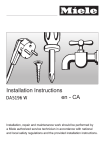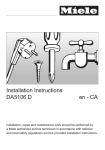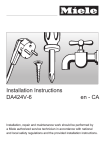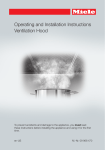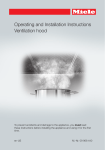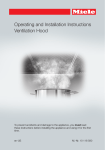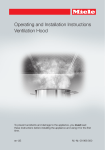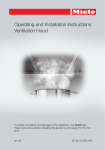Download Miele 09 968 280 Technical data
Transcript
Installation Instructions DA6596 W en - CA Installation, repair and maintenance work should be performed by a Miele authorized service technician in accordance with national and local safety regulations and the provided installation instructions. Installation Before installation Before installing the appliance, read all of the information contained in this chapter and also in the "IMPORTANT SAFETY INSTRUCTIONS" section. Removing the protective film Disassembly If the device ever needs to be disassembled, follow the installation sheet instructions in reverse order. A lever is provided to assist with the removal of the chimney. Unscrew the two mounting screws on the chimney. The housing components are covered by a protective film to prevent them from becoming damaged during transport. Please remove this film before installing the housing components. It can be peeled off easily without any additional tools. Installation Instructions Please refer to the accompanying installation sheet for instructions on how to install the appliance. Slide the supplied lever between the chimney and the extension piece. Pry the chimney out of its attachment. 31 Installation Installation parts 32 Installation a 3 protective installation sheets for use when installing the chimney b 1 exhaust connector for an exhaust duct 6" (150 mm). c 1 reducer for an exhaust duct 5" (125 mm). d 1 non-return flap for installation in the outlet duct collar of the motor unit (not for recirculation mode). Depending on the device version, the non-return flap is already mounted. e Telescopic wall bracket for securing the ventilation hood on the wall. f Recirculation kit for recirculation mode contains diverter, aluminum hose and hose clamps (only for DA 6596 W, not contained in scope of delivery, available as optional accessory – see "Technical Data"). 6 screws ³/₁₆" x 2 ³/₈" (5 x 60 mm) and 6 plugs ⁵/₁₆" x 2" (8 x 50 mm) for attaching to the wall. (Plugs not for use in UDS / CDN.) The screws and plugs are designed for use in solid walls only. Use different fasteners for other wall construction types. Make sure that the wall can support the load. 2 x M 6 locknuts for mounting the appliance unit. 2 screws ¹/₈" x ⁵/₁₆" (3.9 x 7.5 mm) for attaching the chimney. 1 lever for disassembling the chimney. Mo e ntag tallation aje gio nt Ins Mo Montag ntering agem s nt Mo Mo Asennu Installation sheet 33 Installation Appliance dimensions The drawing is not to scale. a Extraction b Recirculation (only DA 6596 W) c Air vent positioned at the top for recirculation 34 Installation de Installation area (only d is required for recirculation ventilation hoods). Wall and ceiling area for exhaust duct opening and for wall socket installation. Only the wall socket installation is required for recirculation hoods. Vent collar 6" (150 mm), with adapter 5" (125 mm). Distance between cooktop and ventilation hood (S) Provided a larger distance is not given by the manufacturer of the cooktop, follow the minimum safety distances between a cooktop and the bottom of the hood. Please also observe the information contained in the "IMPORTANT SAFETY INSTRUCTIONS" section. Minimum distance S Cooking appliance Miele appliance Non-Miele appliance Electric/Induction cooktop 24" (610 mm) Electric grill, deep fat fryer (electric) 26" (660 mm) Multi-burner gas cooktop ≤ 43,000 BTU/hr (12.6 W), no burner > 15,000 BTU/hr (4.5 kW). 26" (660 mm) 30" (760 mm) Multi-burner gas cooktop ≤ 73,800 BTU/hr (21.6 W), no burner > 16,500 BTU/hr (4.8 kW) 30" (760 mm) Multi-burner gas cooktop > 73,800 BTU/hr (21.6 W), or one of the burners > 16,500 BTU/hr (4.8 kW) Not possible Single-burner gas cooktop ≤ 20,500 BTU/hr (6 kW) 26" (660 mm) 30" (760 mm) Single-burner gas cooktop ≤ 27,600 BTU/hr (8.1 kW) 30" (760 mm) Single-burner gas cooktop > 27,600 BTU/hr (8.1 kW) Not possible 35 Installation Installation recommendations – We also recommend a distance of at least 25 ¹/₂" (650 mm) above electric cooktops to provide more workspace and easier cooking under the hood. Drilling diagram for wall mounting When drilling, please follow the directions contained on the accompanying installation sheet. – When selecting an installation height, always take the user height into consideration. Users should have ample space to work comfortably on the cooktop and reach the ventilation hood controls with ease. – Please note that the greater the distance from the cooktop, the less effective the hood is at drawing in the cooking vapors. – To achieve optimal vapor extraction, make sure that the hood covers the cooktop. The hood should be positioned centrally over the cooktop, not to the side or rear. – The cooktop should be no wider than the hood. Preferably, it should be narrower. – The mounting area must be easily accessible. The ventilation hood should be easy to reach and disassemble in case a service call is necessary. This should be taken into consideration when planning the position of cupboards, shelves, ceilings or decorative elements in the vicinity of the ventilation hood. 36 When installing a custom back wall with pre-drilled holes, please refer to the drilling distances in the drawing above (screws ³/₁₆" (5 mm)). Installation Plywood backing The majority of the weight of the installed ventilation system will be supported by the lower retaining plate. It must be firmly attached to the stud framing behind the drywall. If studs are not available in the required locations, a plywood backing (min. ½" (13 mm) thick) spanning at least two studs must be installed. Failure to adequately support the weight as stated may result in the ventilation system falling off the wall, causing personal injury and property damage. If plywood backing is not needed, proceed to the included "Installation diagram". To install a plywood backing Make a cutting line 3" (76 mm) above and 3" (76 mm) below the outline of the retaining plate. Find the studs to the left and right of the mounting location by tapping the wall or using a stud finder. Mark a vertical cutting line along the center of each stud. CAUTION: When cutting or drilling into the wall or ceiling, do not damage electrical wiring and other hidden utilities. Remove the drywall between the cutting lines and replace it with plywood of a matching thickness (min. ½" (13 mm) thick). Tape the joints and refinish the wall. Proceed to the enclosed "Installation diagram" to complete the installation. Determine and mark the location of the retaining plate for the canopy as outlined on the "Installation diagram". 37 Exhaust duct WARNING: Danger of toxic fumes. Gas cooking appliances release carbon monoxide that can be harmful or fatal if inhaled. To reduce the risk of fire and to properly exhaust air, the exhaust gases extracted by the hood should be vented outside of the building only. Do not vent exhaust air into spaces within walls or ceilings or in attics, crawl spaces or garages. To reduce the risk of fire, only use metal ductwork. Please read and follow the "IMPORTANT SAFETY INSTRUCTIONS" to reduce the risk of personal injury. Follow all local building codes when installing the hood. Only use smooth pipes or flexible duct hoses made from nonflammable materials for exhaust ductwork. To achieve the greatest possible air extraction with the lowest noise levels, please note the following: – The diameter of the exhaust duct should not be less than 6" (150 mm). – If flat exhaust ducts are used, the cross section should not be smaller than that of the exhaust connector. – The exhaust duct should be as short and straight as possible. – If elbows are needed, make sure they have a large radius. – The exhaust duct itself must not be kinked or compressed. 38 – Make sure that all connections are secure and airtight. Remember that any constriction of the airflow will reduce extraction performance and increase operating noise. If the exhaust duct is to be routed through an outside wall, we recommend installing a telescopic wall vent or a rooftop vent (available as an optional accessory). If the exhaust air is to be conducted into a vent flue, the intake piece must be aligned with the flow direction of the flue. When installing the exhaust duct horizontally, you must slope it away from the source by at least 1 cm per meter (³/₈" per 3 ¹/₄"). This ensures that condensate cannot drain back into the ventilation hood. If the exhaust duct is to be routed through rooms, ceiling space etc., the temperatures in these different areas may differ greatly, which means that the problem of condensation will need to be addressed. The exhaust duct will need to be insulated. Exhaust duct Condensate trap Reducing Collar (optional accessory) In addition to insulating the exhaust duct, we recommend installing a condensate trap to collect and evaporate any condensate which might accumulate. Condensate traps are available for exhaust ducts with a diameter of 5" (125 mm) or 6" (150 mm). When installing a condensate trap, make sure that it is positioned vertically and, if possible, directly above the hood outlet duct collar. The arrow on the housing indicates the direction of airflow. If you would like to reduce the environmental impact of your ventilation system by limiting the CFM output the Reducing Collar can be installed. It reduces the air flow to less than 400 CFM. Check local building codes for max. CFM requirements. Push the Reducing Collar on the exhaust port of the fan. Push the exhaust hose over it. Fix both with a hose clamp. 39 Electrical connection WARNING: TO REDUCE THE RISK OF FIRE, ELECTRIC SHOCK, OR INJURY TO PERSONS, OBSERVE THE FOLLOWING: All electrical work should be performed by a qualified electrician in strict accordance with national regulations (for USA: ANSI-NFPA 70) and local safety regulations. Installation, repairs and other work by unqualified persons could be dangerous. Ensure that power to the appliance is OFF while installation or repair work is performed. Verify that the voltage, load and circuit rating information found on the data plate (located behind the baffle filters), match the household electrical supply before installing the hood. Use only with ventilation hood cordconnection kits that have been investigated and found acceptable for use with this model hood. If there is any question concerning the electrical connection of this appliance to your power supply, please consult a licensed electrician or call Miele’s Technical Service Department. WARNING: THIS APPLIANCE MUST BE GROUNDED The hood comes equipped with a power cord with a NEMA 5-15 molded plug for connection to a 120 VAC, 60 Hz, 15 A power outlet. 40 Grounding Instructions WARNING - Improper grounding can result in a risk of electric shock. This appliance must be grounded. In the event of an electrical short circuit, grounding reduces the risk of electric shock by providing a path of least resistance. This appliance is equipped with a cord having a grounding wire with a grounding plug. If there is any doubt, have the electrical system of the house checked by a qualified electrician. Do not use an extension cord. If the power supply cord is too short, have a qualified electrician install an outlet near the appliance. The plug must be plugged into an outlet that is properly installed and grounded. WARNING - Grounding instructions (Canada) The grounding-type attachment plug shall be connected to a groundingtype receptacle installed in accordance with CSA C22.1-12, Canadian Electrical Code, Part I. Activating Con@ctivity 2.0 Installation of the Con@ctivity 2.0 stick In order for you to be able to use the Con@ctivity 2.0 function, the cooktop must be equipped with a Con@ctivity 2.0 stick. See the relevant installation instructions of the Con@ctivity 2.0 stick. Activating the ventilation hood Turn off the fan, cooktop lighting and cooktop. Press the Delayed shut down button 515 for approx. 10 seconds until the 1 indicator appears in the fan level display. Then, press the following buttons in order: Activating Con@ctivity 2.0 – The "" button To use the Con@ctivity 2.0 function, the radio link between the cooktop and the hood must be activated. – Followed by the "" button Both appliances must be installed and operational. – And then the lighting button . If Con@ctivity 2.0 has not been activated, the indicators for levels 2 and 3 will flash at the same time. You only need to carry out the activation procedure once. If the appliances are disconnected from the electricity supply, for example during a loss of power, they will still remain activated. To activate Con@ctivity 2.0, press the "" button. To establish radio connection, the ventilation hood and cooktop must be activated at the same time. Start activation on the ventilation hood first, and then begin activation on the cooktop. As this is happening, begin activation on the cooktop. The hood begins searching for a radio connection. Indicator 2 is continuously lit, and the indicator 3 flashes. Activating the cooktop While the ventilation hood is searching for a signal, start activation on the cooktop. More information can be found in the operating instructions for the cooktop. Once the radio connection has been established, the indicators 2 and 3 on the hood are continuously lit. Confirm activation of the ventilation Confirm activation on the cooktop. 41 Activating Con@ctivity 2.0 The Con@ctivity 2.0 function is now ready for use. If you do not confirm within 4 minutes, activation will be canceled. Checking activation To check whether Con@ctivity 2.0 has been activated for the hood: Turn off the fan and cooktop lighting. Press the Delayed shut down button 515 for approx. 10 seconds until the 1 indicator appears in the fan level display. Then, press the following buttons in order: – The "" button – Followed by the "" button – And then the lighting button . If Con@ctivity 2.0 has been activated, the indicators for levels 2 and 3 will be constantly lit. If Con@ctivity 2.0 has not been activated, the indicators for levels 2 and 3 will flash simultaneously. To exit the check, press the Delayed shut down button 515. All indicators will go out. To check whether activation has taken place on the cooktop, please refer to corresponding operating instructions. If a connection cannot be established despite activation of the Con@ctivity function on the hood and the cooktop, the function must first be deactivated and then reactivated on both appliances. 42 Deactivating Con@ctivity 2.0 Deactivation on the hood is similar to the activation procedure. Select the "" button instead of the "" button. To deactivate the cooktop, please refer to the corresponding operating instructions. Please keep in mind that disabling the connection will also disable any remote control function being used. The remote control must then be reactivated. Service and warranty For faults that you cannot resolve on your own, please contact your Miele dealer or Miele Technical Service. The telephone number for the Technical Service Department is listed at the back of these instructions. When contacting Miele, please state the model and serial number of your ventilation hood. These can be found on the data plate. Location of the data plate The data plate is visible once you have removed the grease filters. Warranty For further information, please refer to your warranty booklet. 43 Technical data Fan motor Cooktop lighting Total connected load Voltage, Frequency Fuse rating Power cord length 350 W 3x3W 359 W 120 V AC, 60 Hz 15 A 2.5 ft (0.75 m) Weight DA 6596 W 55 lbs (25 kg) DA 6526 W 61.6 lbs (28 kg) Optional accessories for recirculation mode: Recirculation kit DUW 20 and OdorFree Charcoal Filter DKF 12 Contains FCC ID: 2ACUWEI8800 IC: 5669C-EI8800 This device complies with Part 15 of the FCC Rules and with Industry Canada licence-exempt RSS standard(s). Operation is subject to the following two conditions: (1) this device may not cause harmful interference, and (2) this device must accept any interference received, including interference that may cause undesired operation. 44 Please have the model and serial number of your appliance available before contacting Technical Service. U.S.A. Canada Miele, Inc. Importer Miele Limited National Headquarters 9 Independence Way Princeton, NJ 08540 Phone: 800-843-7231 609-419-9898 609-419-4298 Fax: www.mieleusa.com Technical Service & Support Nationwide Phone: 800-999-1360 888-586-8056 Fax: [email protected] Headquarters and Miele Centre 161 Four Valley Drive Vaughan, ON L4K 4V8 www.miele.ca Customer Care Centre Phone: 800-565-6435 905-532-2272 [email protected] Germany Manufacturer Miele & Cie. KG Carl-Miele-Straße 29 33332 Gütersloh 45 DA 6596 W DA 6526 W en-US M.-Nr. 09 968 470 / 00



















